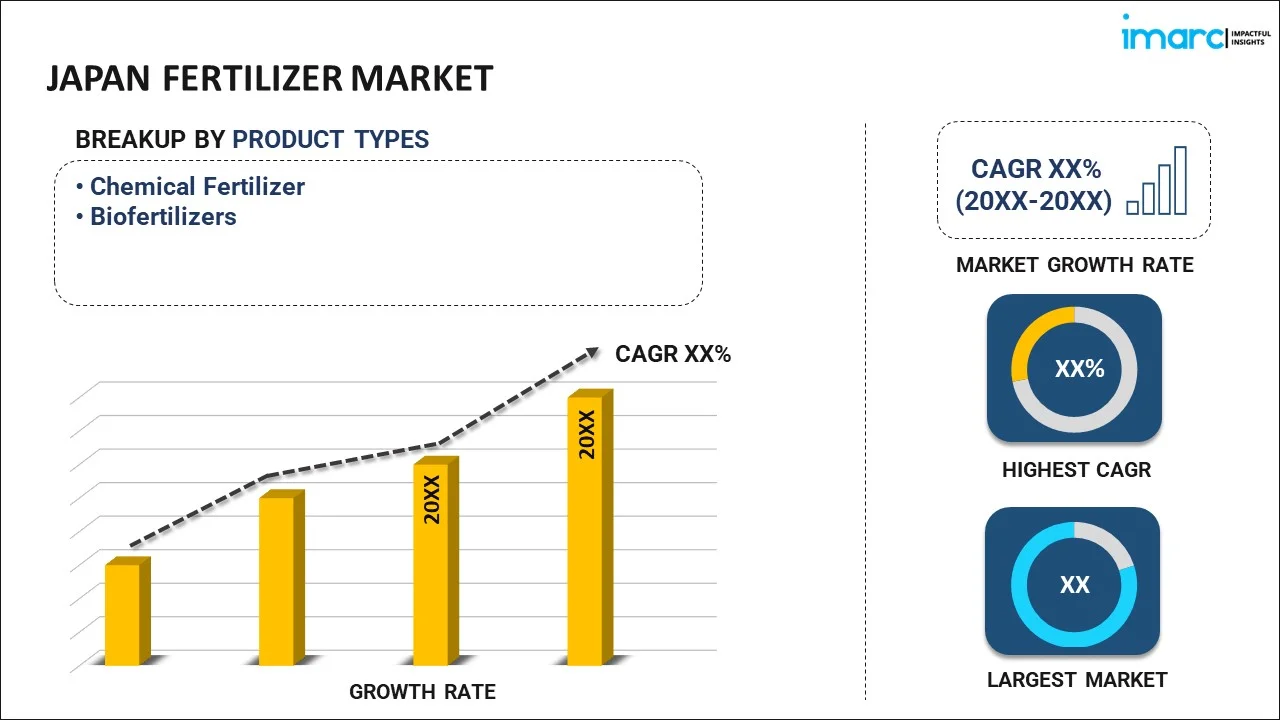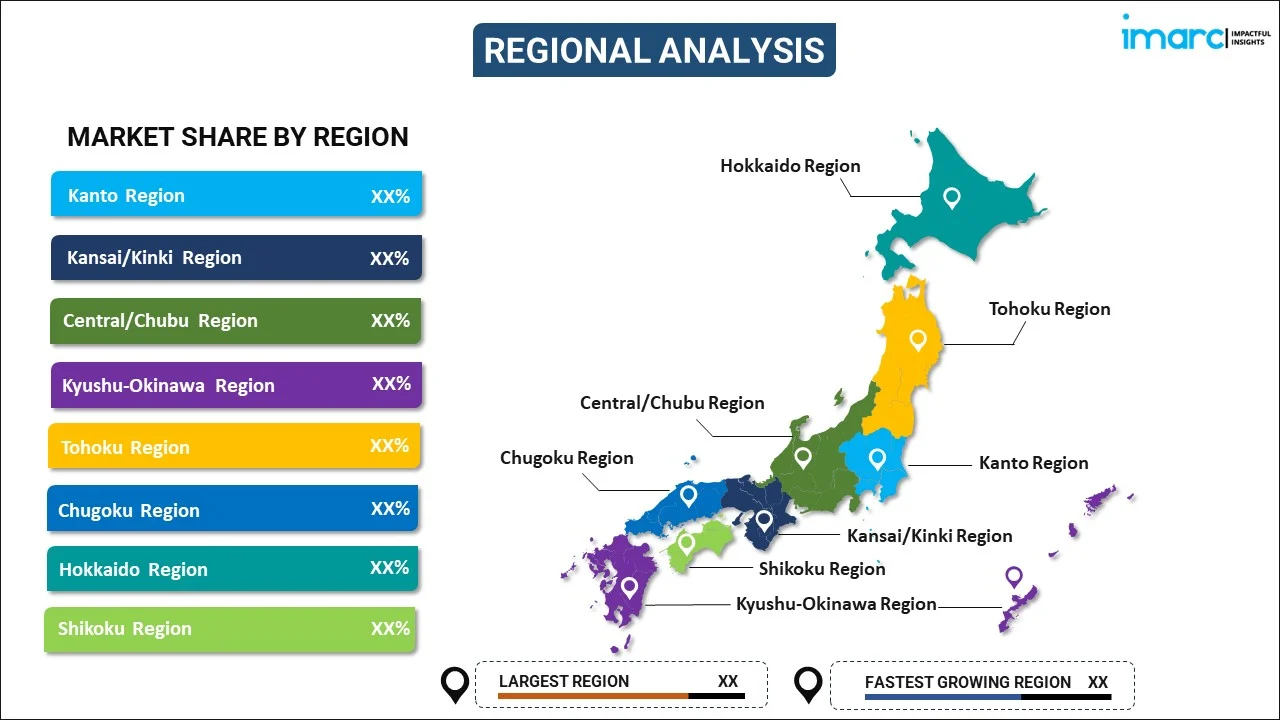
Japan Fertilizer Market Report by Product Type (Chemical Fertilizer, Biofertilizers), Product (Straight fertilizers, Complex Fertilizers), Product Form (Dry, Liquid), Crop Type (Grains and Cereals, Pulses and Oilseeds, Fruits and Vegetables, Flowers and Ornamentals, and Others), and Region 2025-2033
Market Overview:
Japan fertilizer market size reached USD 5.5 Billion in 2024. Looking forward, IMARC Group expects the market to reach USD 7.6 Billion by 2033, exhibiting a growth rate (CAGR) of 3.4% during 2025-2033. The escalating demand for agricultural products that lead to an increased need for fertilizers to enhance crop yields and ensure food security, is driving the market.
|
Report Attribute
|
Key Statistics
|
|---|---|
|
Base Year
|
2024 |
|
Forecast Years
|
2025-2033
|
|
Historical Years
|
2019-2024
|
| Market Size in 2024 | USD 5.5 Billion |
| Market Forecast in 2033 | USD 7.6 Billion |
| Market Growth Rate (2025-2033) | 3.4% |
Fertilizer is a substance or mixture, natural or synthetic, that is applied to soil or plants to supply essential nutrients for optimal growth and productivity. It plays a crucial role in agriculture by replenishing the nutrients that are depleted from the soil due to continuous crop cultivation. Generally, fertilizers contain varying combinations of essential elements such as nitrogen, phosphorus, and potassium, along with secondary and trace elements like calcium, magnesium, sulfur, and others, depending on the specific needs of the crops being cultivated. These nutrients aid in promoting healthy plant development, enhancing crop yields, and improving overall crop quality. While natural fertilizers, such as manure and compost, have been used for centuries, the development of synthetic fertilizers revolutionized modern agriculture, enabling farmers to meet the demands of an ever-growing population. However, the overuse and improper application of fertilizers can lead to environmental degradation, including water pollution and soil degradation, emphasizing the importance of sustainable and balanced fertilizer use in modern agricultural practices.
Japan Fertilizer Market Trends:
The fertilizer market in Japan is influenced by various drivers, which collectively shape its dynamics. Firstly, with the ever-expanding regional population, the demand for food is escalating, thereby necessitating an increase in agricultural productivity. Consequently, the need for fertilizers is amplified to enhance crop yields and ensure food security. Moreover, considering the rising awareness about sustainable agriculture, the shift towards organic and environment-friendly fertilizers is gaining traction. Consequently, manufacturers are investing in R&D to cater to this growing demand for eco-friendly alternatives. Additionally, the emergence of precision farming techniques is driving the demand for customized fertilizers tailored to specific soil and crop requirements. This trend is fostering innovation in the fertilizer sector, prompting companies to develop specialized products that address the unique needs of different crops and soil types. Furthermore, government initiatives and subsidies aimed at promoting agricultural development and enhancing crop productivity are expected to drive the fertilizer market in Japan during the forecast period.
Japan Fertilizer Market Segmentation:
IMARC Group provides an analysis of the key trends in each segment of the market, along with forecasts at the country level for 2025-2033. Our report has categorized the market based on product type, product, product form, and crop type.
Product Type Insights:

- Chemical Fertilizer
- Biofertilizers
The report has provided a detailed breakup and analysis of the market based on the product type. This includes chemical fertilizer and biofertilizers.
Product Insights:
- Straight Fertilizers
- Nitrogenous Fertilizers
- Urea
- Calcium Ammonium Nitrate
- Ammonium Nitrate
- Ammonium Sulfate
- Anhydrous Ammonia
- Others
- Phosphatic Fertilizers
- Mono-Ammonium Phosphate (MAP)
- Di-Ammonium Phosphate (DAP)
- Single Super Phosphate (SSP)
- Triple Super Phosphate (TSP)
- Others
- Potash Fertilizers
- Muriate of Potash (MoP)
- Sulfate of Potash (SoP)
- Secondary Macronutrient Fertilizers
- Calcium Fertilizers
- Magnesium Fertilizers
- Sulfur Fertilizers
- Micronutrient Fertilizers
- Zinc
- Manganese
- Copper
- Iron
- Boron
- Molybdenum
- Others
- Nitrogenous Fertilizers
- Complex Fertilizers
A detailed breakup and analysis of the market based on the product have also been provided in the report. This includes straight fertilizers [nitrogenous fertilizers (urea, calcium ammonium nitrate, ammonium nitrate, ammonium sulfate, anhydrous ammonia, and others), phosphatic fertilizers (mono-ammonium phosphate (MAP), di-ammonium phosphate (DAP), single super phosphate (SSP), triple super phosphate (TSP), and others), potash fertilizers (muriate of potash (MoP) and sulfate of potash (SoP)), secondary macronutrient fertilizers (calcium fertilizers, magnesium fertilizers, and sulfur fertilizers), and micronutrient fertilizers (zinc, manganese, copper, iron, boron, molybdenum, and others)] and complex fertilizers.
Product Form Insights:
- Dry
- Liquid
The report has provided a detailed breakup and analysis of the market based on the product form. This includes dry and liquid.
Crop Type Insights:
- Grains and Cereals
- Pulses and Oilseeds
- Fruits and Vegetables
- Flowers and Ornamentals
- Others
A detailed breakup and analysis of the market based on the crop type have also been provided in the report. This includes grains and cereals, pulses and oilseeds, fruits and vegetables, flowers and ornamentals, and others.
Regional Insights:

- Kanto Region
- Kansai/Kinki Region
- Central/ Chubu Region
- Kyushu-Okinawa Region
- Tohoku Region
- Chugoku Region
- Hokkaido Region
- Shikoku Region
The report has also provided a comprehensive analysis of all the major regional markets, which include Kanto Region, Kansai/Kinki Region, Central/ Chubu Region, Kyushu-Okinawa Region, Tohoku Region, Chugoku Region, Hokkaido Region, and Shikoku Region.
Competitive Landscape:
The market research report has also provided a comprehensive analysis of the competitive landscape. Competitive analysis such as market structure, key player positioning, top winning strategies, competitive dashboard, and company evaluation quadrant has been covered in the report. Also, detailed profiles of all major companies have been provided.
Japan Fertilizer Market Report Coverage:
| Report Features | Details |
|---|---|
| Base Year of the Analysis | 2024 |
| Historical Period | 2019-2024 |
| Forecast Period | 2025-2033 |
| Units | Billion USD |
| Scope of the Report | Exploration of Historical Trends and Market Outlook, Industry Catalysts and Challenges, Segment-Wise Historical and Future Market Assessment:
|
| Product Types Covered | Chemical Fertilizer, Biofertilizers |
| Products Covered |
|
| Product Forms Covered | Dry, Liquid |
| Crop Types Covered | Grains and Cereals, Pulses and Oilseeds, Fruits and Vegetables, Flowers and Ornamentals, Others |
| Regions Covered | Kanto Region, Kansai/Kinki Region, Central/ Chubu Region, Kyushu-Okinawa Region, Tohoku Region, Chugoku Region, Hokkaido Region, Shikoku Region |
| Customization Scope | 10% Free Customization |
| Post-Sale Analyst Support | 10-12 Weeks |
| Delivery Format | PDF and Excel through Email (We can also provide the editable version of the report in PPT/Word format on special request) |
Key Questions Answered in This Report:
- How has the Japan fertilizer market performed so far and how will it perform in the coming years?
- What has been the impact of COVID-19 on the Japan fertilizer market?
- What is the breakup of the Japan fertilizer market on the basis of product type?
- What is the breakup of the Japan fertilizer market on the basis of product?
- What is the breakup of the Japan fertilizer market on the basis of product form?
- What is the breakup of the Japan fertilizer market on the basis of crop type?
- What are the various stages in the value chain of the Japan fertilizer market?
- What are the key driving factors and challenges in the Japan fertilizer?
- What is the structure of the Japan fertilizer market and who are the key players?
- What is the degree of competition in the Japan fertilizer market?
Key Benefits for Stakeholders:
- IMARC’s industry report offers a comprehensive quantitative analysis of various market segments, historical and current market trends, market forecasts, and dynamics of the Japan fertilizer market from 2019-2033.
- The research report provides the latest information on the market drivers, challenges, and opportunities in the Japan fertilizer market.
- Porter's five forces analysis assist stakeholders in assessing the impact of new entrants, competitive rivalry, supplier power, buyer power, and the threat of substitution. It helps stakeholders to analyze the level of competition within the Japan fertilizer industry and its attractiveness.
- Competitive landscape allows stakeholders to understand their competitive environment and provides an insight into the current positions of key players in the market.
Need more help?
- Speak to our experienced analysts for insights on the current market scenarios.
- Include additional segments and countries to customize the report as per your requirement.
- Gain an unparalleled competitive advantage in your domain by understanding how to utilize the report and positively impacting your operations and revenue.
- For further assistance, please connect with our analysts.
 Inquire Before Buying
Inquire Before Buying
 Speak to an Analyst
Speak to an Analyst
 Request Brochure
Request Brochure
 Request Customization
Request Customization




.webp)




.webp)












